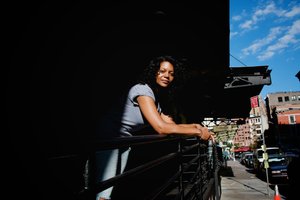In Conversation: Tara Duvivier
Tara Duvivier, Pratt Center Senior Planner, spent two years leading a community engagement process in the South Bronx neighborhood of Hunts Point. The catch? She did it during a pandemic. In conversation with Pratt Center’s Elmo Tumbokon, she shares what her experience can reveal how planners can stop burdening the communities they want to help and how they can be part of the community instead. This conversation has been edited for length and clarity.

Elmo Tumbokon: Over the past year you’ve been working on a project called Hunt’s Point Forward. Can you tell us a little bit about it?
Tara Duvivier: Sure! Hunts Point Forward is, basically, a process and a vision for the community of Hunts Point.
In 2004, there was a major planning process within Hunts Point which resulted in hundreds of millions of investment in green space, parks, some traffic safety measures, and more. A lot of projects resulted from that process.
But, as time went on, there were other new projects coming up — specifically, the redevelopment of the former Spofford Juvenile Detention Center and the Bruckner Expressway redesign — that the community felt they were being left out of. They wanted to get everyone back to the table. Not only to figure out how these few specific projects were going to impact the neighborhood but also to really think about the whole neighborhood for the next 15 years.
This bigger picture work was something the Hunts Point-Longwood Community Coalition really desired. They are a coalition of different community organizations that serve the Hunts Point and Longwood communities. Several years ago, they realized: “We all serve these communities in different capacities. We should get together regularly and serve as a power building tool to advocate for bigger and better things. We will be stronger if we are united.”
I think it's an incredible model. Having this group to anchor the project was really important for our success.
But formally speaking, Hunts Point Forward is a plan with over seventy recommendations that prioritizes healthy bodies, healthy minds, a livable environment, connectivity, shared prosperity, and accountability — all made possible because the coalition wanted to get back to the table with the City.
ET: And what was Pratt Center’s involvement in all this?
TD: The Coalition reached out to Pratt Center. They were like, “Hey, guys! We want to do a bit of a look back from the 2004 plan and think through all these new projects. Do you think you can help us?”
We, meaning Pratt Center, were interested in joining the project because of our history in the neighborhood. We were initially called in to provide technical assistance, but Pratt Center ended up leading Hunts Point Forward’s community engagement plan as the project rolled on and formalized into a larger scale project.

ET: This community engagement happened during the beginning of the pandemic which I’m sure wasn’t easy. What does community engagement during COVID look like?
TD: Prior to the pandemic, we were definitely looking to do a very robust community engagement and thinking through ways to try to engage the public in ways other than just having public meetings. I mean really doing things on the ground. We thought: “We’re gonna be out in the community, we're gonna set up around the community. We're going to be engaging people in ways that they wouldn't typically expect.” That was really the approach that we hoped to take. Then, just when we were getting started, we were already shut down.
When the pandemic began, everyone from EDC (Economic Development Corporation) to Hunts Point-Longwood Community coalition diverted all their attention doing all of these emergency response measures. Our greatest concern was: “Who is doing a community engagement process and who’s going to engage with us if people are concerned for their health and their livelihoods?”
So, for some time the project was delayed. And even when we got the call telling us it was time to start, all the community organizations were still very stretched doing emergency response. Navigating this dynamic was a constant challenge in trying to do community based planning during a pandemic, but it also became Hunts Point Forward’s biggest strength.
ET: How so?
TD: In community-based planning, we always have to be aware of the social infrastructure. There are already community groups on the ground. They're already doing the thing. But, groups that were normally doing job placement programs are now doing emergency food distribution. We don't want to exhaust them and say, “Hey! You know we want to do a whole other thing, so we need some of your resources.” No. We can’t be a burden to the people we serve. We need to figure out what the community is already doing and how we could integrate our process into that.
I think the most successful example of that was the survey we created. The best way to get folks to fill out surveys during the pandemic was when The Point CDC and Urban Health Plan, members of the Coalition, did a month and a half of vaccinations in the community. After betting the vaccine, people had to sit for 15 minutes and be observed, and in those 15 minutes they filled out a survey. We got hundreds of survey responses that way.
When the spring and summer hit and things started to warm up and Covid rates started to go down, people were outside. It was a little more safe to engage folks, even though we weren't going to be having any large meetings with hundreds of people. Where there were smaller scale community events that were outdoors, we participated. We were there letting people know about Hunts Point Forward, giving people surveys, and seeing if they were willing to fill them out or talk with us more informally. All of this was arranged through the coalition, we just incorporated ourselves so we weren't giving them extra work. We also helped enhance the event by being there to engage with the community and, in some instances, provide resources like catering. All of this helped alleviate the pressure on our partners, while engaging the community to share their vision with us.

ET: I remember watching the Hunts Point Forward release ceremony and people were giving really high praise. Andrew Kimball of EDC said, “When it comes to community planning, I’m not sure I’ve seen anything better than this.” My question is: What’s your biggest takeaway about community-based planning after all this?
TD: I think the biggest thing is that community-based planning needs to not burden communities. Communities, especially ones like Hunts Point, are already over-researched and over-studied. And they will tell you this! There are so many different studies and plans that they're almost “over-planned,” you know?
Planners are constantly going back to the same people to ask them the questions that they already answered for someone else. Even worse, the people are not seeing the progress. They often see no results from talking with planners. It’s an awful thing to put a community through. It is still important to talk to people, though. We need community input especially for a project of this scale. But we have to do it in a way that does not burden them. Working alongside them rather than adding to their plate is really key. And again, providing resources is something you’re starting to see more and more: a lot of meetings where childcare is provided or travel accommodations. Just putting out candy at a table and expecting people to talk to you for half an hour is not gonna cut it anymore.
We need to be able to incorporate into the community, to shift from the planner’s birds eye perspective down to the street level in all areas of our work.
And that includes language! One thing that bothers me the most is the inaccessibility of our language in community-based planning. And this isn’t a slight against anyone’s intelligence or on the professionalism of planners. It just does not make sense to go into a community and throw out planner-speak when we are not talking to planners. People think planner speak makes us sound so smart, but there’s nothing smart about not being able to connect with the community because we feel we need to say all those big words.
We need to understand that although not everyone has the same level of education that does not mean they don't have the same level of intelligence. We need to speak in a way people can understand. That's something really key in community-based planning and it may seem obvious, but it's something that I don't think we're working hard enough at.
ET: So what’s next for Hunts Point Forward?
TD: What's next is working with the City and the Coalition to get some of these recommendations implemented. This report is not like the 2004 report, where there was money already identified and set aside for these recommendations. So that's really the next step: figuring out how to prioritize these recommendations and how to advocate and work with the City to get the funding to implement them.